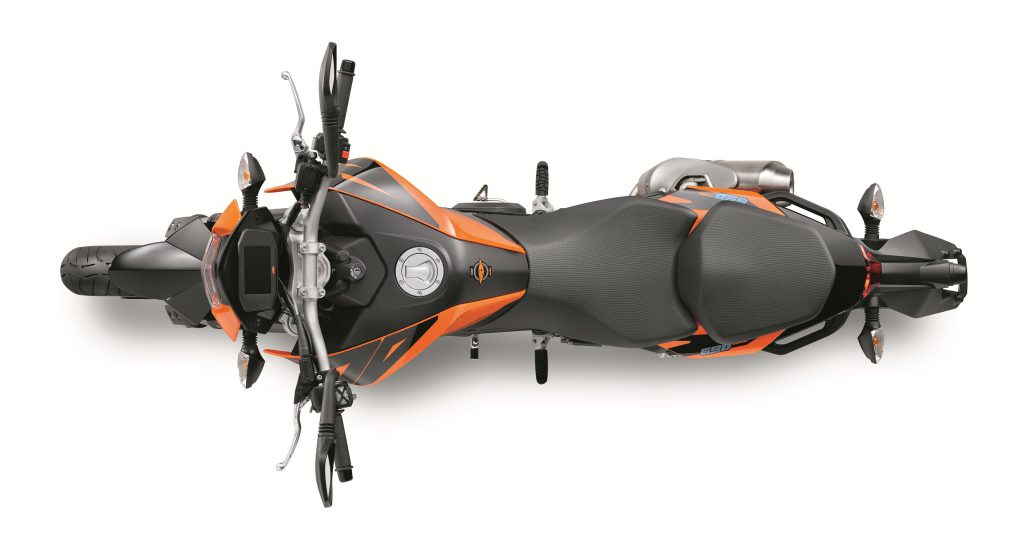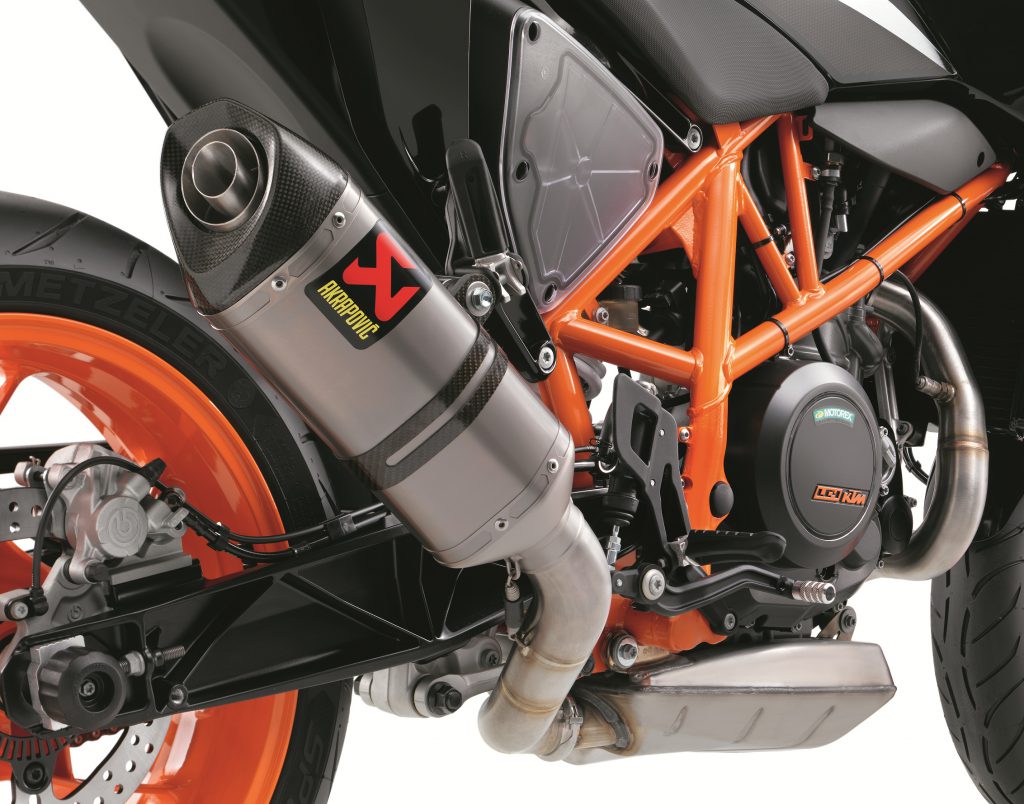Some manufacturers are fortunate enough to have one or two models within their range that really strike a chord with the buying public – bikes with that X-factor that really sell their socks off. Then there are manufacturers who hit the jackpot with a range of bikes that garner such a following they become a brand within a brand. Austrian company KTM has achieved just such a feat with its Duke range, and it all started with its very first rough and ready roadbike, the 620 Duke, built from a dirtbike base 22 years ago.
Last year I was lucky enough to travel to Thailand for the inaugural ‘Duke It’ event, KTM’s celebration of its famous range. The entire line-up, from the little 125 through to a race-spec 1290 Super Duke R, was served up like a smorgasbord of two-wheel mechanical delights. Each was thrashed on the road and racetrack, all in the name of entertaining copy (see Vol 64 No 20).
If you imagine the event, I’m sure the first image that pops into many of your minds is of the 1290 Super Duke R at full lean with the rider’s knee on the deck. Understandable, given the 1290’s justified reputation as an amazing piece of adrenalin-inducing kit. However, when it comes to out-and-out enjoyment it’s the company’s foundation roadbike, the 690 Duke and up-spec 690 Duke R, that will give you riding enjoyment at its purest and funnest. KTM has given its 693cc big-bore, single- cylinder naked a technical touch-up for this year, and as I discovered at its recent world launch over in Spain’s Canary Islands, there remains a lot to like about being single.

The highlight of the launch was a tracksession at the Circuito de Maspalomas at Gran Canaria – the perfect place to stretch the legs of the 55kW/74Nm nakedbike and really put it through its paces. And barely three minutes into that session I got the chance to put the Brembo brakes, stability control and Bosch ABS systems to the test. Being a bit of a chatterbox I had been slow to get my helmet on for the so-called orientation laps of a circuit I had only first laid eyes on 10 minutes earlier. The group leader, being followed by a line of international media, was already halfway around the first lap by the time I left the pitlane.
I was on the 690 Duke R, which has a choice of three riding modes, a fully adjustable WP fork and shock (replacing the non-adjustable kit on the standard model), Akrapovič exhaust, adjustable rear-set ’pegs allowing more lean angle, one whole extra kilowatt of power and one kilogram less of weight. It’s an upgrade that’s hard to resist when you’re given the choice. Sure, the standard model is also a very capable machine, and probably just as fast in the hands of a track hack like myself, but when you thumb the ignition switch on the R and bask in the single-cylinder thump from the titanium exhaust, it’s addictive and heady stuff.
So as my nether regions quickly filled with a mixture of adrenalin and vinegar,
I fired out of pitlane in hot pursuit of the pack without much thought for the actual track layout. These few hours of unrestricted speed were our reward for surviving a day screaming over the top and down into the depths of the island’s many canyons via a seemingly endless run of twisting and turning roads – the type of road motorcyclists dream about. Unlike our dreams, however, the real road also attracts tour buses, drivers distracted by the incredible views, and pushbike riders in their thousands. So while the morning ride was brilliant, it did require a little restraint. Being able to rev the living daylights out of the Austrian middleweight nakedbike on a racetrack highlighted just how capable it is.
Beginning my first lap, the observation group was still well ahead, and with no circuit knowledge or leading rider’s tail lights to call on I found myself popping over the brow of the blind left-right flip- flop at the end of the main straight at reasonable speed. But the track did not go straight ahead as expected – it turned left into a 180o hairpin bend.
I couldn’t do much more than throw the bike into the corner while my right hand forcefully pushed hydraulic fluid through the radial- mounted master cylinder to the four-piston M50 monobloc caliper up front, instructing it to bite as aggressively as possible onto the single 320mm disk. Meanwhile my right foot did the same with the single piston rear Brembo and 240mm disk.

IT ALL STARTED 22 YEARS AGO WITH ITS VERY FIRST ROUGH AND READY ROADBIKE THE 620 DUKE
While the standard 690 Duke differs from the R model with a standard Brembo four-piston caliper and axial master cylinder, there’s a split-hair difference in the braking performance when faced with a safety or sandtrap situation. Thankfully, I had not taken the option of disengaging the two- channel ABS or selecting the Supermoto mode (optional on the standard 690) which allows the rear to lock as the front ABS continues to operate normally. Doing either would probably have seen me still removing sandtrap gravel from my orifices.
Instead I put all of my faith into the KTM/Bosch developed Motorcycle Stability Control (MSC) – a tricky bit of electronic kit that uses a riding dynamics control system to provide lean-angle sensitive ABS, Motorcycle Traction Control (MTC) and Motor Slip Regulation (MSR). Actually, that’s not entirely true. I wasn’t thinking about putting my faith in anything except maybe God as I flicked the lightweight (147.5kg dry) into the the bend with the brakes still very heavily applied. It was only when I opened my eyes and realised I had avoided immeasurable embarrassment that I began to think about how I’d managed to stay upright.
Onto the main straight for the second time I was prepared for the flip-flop-blind-crest-hairpin turn of doom so I pulled the throttle around to the stopper in third gear and enjoyed the even flow of power as I waited for the usual slight drop-off in forward momentum and tortured engine note to tell me it was time to go up a cog. Suddenly I was bouncing off the gentle rev limiter with the gear indicator and engine speed graph on the new for 2016 TFT colour dash turning bright red, screaming at me to change gear.

Turns out that the work carried out by four- stroke engine designer Sebastian Faistauer and his team have on the ageless, water-cooled, OHC LC4 engine for 2016 has lifted what was already a cracking single-pot screamer to a whole new level. Not content with holding the title as the word’s most powerful single-cylinder engine, Sebastian and his KTM buddies decided they wanted more power, less vibration and Euro 4 compliance from the 2016 incarnation, and they have nailed it (see below). Gone are the vibrations through your feet and hands at medium high revs, replaced by a feeling of almost buttery smoothness.
Where the powerplant in the 2015 690 Duke would run out of breath at around 7500rpm as the power curve fell away from its peak 51.5kW, the 2016 engine, with a larger 50mm throttle body (replacing last year’s 46mm unit) and integrated resonance chamber, hits its maximum 55kW(R)/54 kW(S) peak at 8000rpm and holds it there until the 9000rpm rev limiter cuts in. This is 1000rpm higher than the 2015 model and you barely notice a drop in power when you reach it. The engine feels like it would be happy to take on more revs if it was allowed to.
Torque for 2016 is also up, from 69.8Nm to 74Nm, and like the power delivery it really hits its straps at 4500rpm before peaking at 6500rpm.
As the lap tally grew, so did my checklist of things I needed to remember – not to work around any issues, but to train myself to become more at one with the bike… Upshift before you think you need to. Take advantage of the lightness to brake late into corners and pull the bike down at the apex. Use the narrowness and minimal unsprung rotating mass of the single-cylinder design for quicker direction changes. Trust the linear power delivery along with the Metzeler Sportec M7RR tyres, traction and slip control systems. And twist the throttle the second you hit the corner apex to maximise exit speed. Riding a single-cylinder bike does require a little modification of your riding style to extract more from the experience, but it’s a thoroughly enjoyable exercise and it is the key to why riding the 690 Duke is so rewarding, both on the track and on the road.
Make no mistake, the KTM 690 Duke is a proper performance machine, not a pretender. Whether it be the standard model for $12,995 (+ ORC) or the Duke R for $14,995 (+ORC), both offer plenty of bang for your buck in the middleweight class. Sure, owning one requires a little more investment than a twin-cylinder Yamaha MT-07 ($9999 + ORC), but for the extra investment you get Brembo brakes, WP suspension (fully adjustable on the R) and a more expansive electronics suite to enhance your riding enjoyment and keep your tyres firmly connected to the road.











